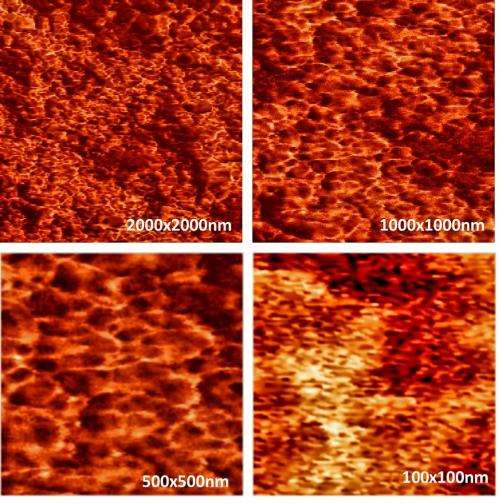Fractal patterns may uncover new line of attack on cancer

Studying the intricate fractal patterns on the surface of cells could give researchers a new insight into the physical nature of cancer, and provide new ways of preventing the disease from developing.
This is according to scientists in the US who have, for the first time, shown how physical fractal patterns emerge on the surface of human cancer cells at a specific point of progression towards cancer.
Publishing their results today, 11 March, in the Institute of Physics and Germany Physical Society's New Journal of Physics, they found that the distinctive repeating fractal patterns develop at the precise point in which precancerous cells transform into cancer cells, and that fractal patterns are not present either before or after this point.
The researchers hope the new findings can inspire biologists to search for specific "weak" points in the pathways that lead to the alteration of precancerous cells at this specific moment. By targeting these weak points, the researchers believe they could influence the process and thus prevent cancer from developing.
Lead author of the study Professor Igor Sokolov said: "Despite many decades of fighting cancer, the war is far from being victorious. A sharp increase in the complexity and variability of genetic signatures has slowed the advancement based on finding specific cancer genes in patients.
"Thus, more than ever, there is a need for new conceptual paradigms about the nature of cancer, and what we have found adds towards the development of such paradigm."
The term "fractal" defines a pattern that, when you take a small part of it, looks similar, although perhaps not identical, to its full structure. For example, the leaf of a fern tree resembles the full plant and a river's tributary resembles the shape of the river itself.
Nature is full of fractal patterns; they can be seen in clouds, lightning bolts, crystals, snowflakes, mountains, and blood vessels. Fractal patterns develop in conditions that are far-from-equilibrium, or chaotic—systems that are not in a state of rest or balance.
In their study, the researchers, consisting of Dr Dokukin and Prof Sokolov from Tufts University and Ms Guz and Prof Woodworth from Clarkson University, used atomic force microscopy to produce extremely high-resolution images of the surfaces of human cervical epithelial cells.
The cells were studied in vitro as they progressed from normal cells to immortal (premalignant) cells to malignant cells.
"Despite previous expectations that fractal patterns are associated with cancer cells, we found that fractal geometry only occurs at a limited period of development when immortal cells become cancerous," Professor Sokolov continued.
"We also found that cells deviate more from fractal when they further progress towards cancer, and confirmed that normal cells do not have fractal patterns."
Whilst it is still unclear if the presence of fractal patterns plays any part in the development or progression of cancer itself, the researchers state that it is definitely plausible to expect that they have some importance given the role that the cell surface plays in metastasis.
Professor Sokolov said: "When cancer metastasizes and spreads through the body, cancer cells have to physically crawl through multiple tissues, overcoming friction and resistance through interactions on the cells surface.
"Moving forward, we need to further our understanding as to how important the cell surface is in the development of cancer."
More information: Emergence of fractal geometry on surface of human cervical epithelial cells during progression towards cancer, M E Dokukin et al 2015 New J. Phys. 17 033019. iopscience.iop.org/1367-2630/17/3/033019
Journal information: New Journal of Physics
Provided by Institute of Physics




















